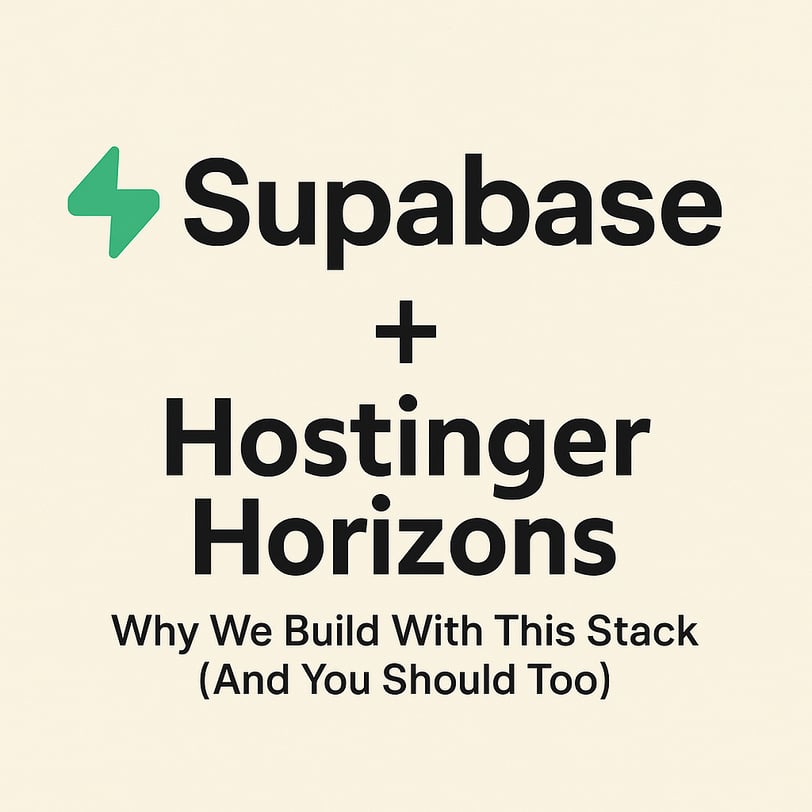Supabase + Hostinger Horizons: Why We Build With This Stack
Discover why Supabase and Hostinger Horizons are our go-to tech stack for building fast, scalable web apps—no SQL or backend headaches required. Learn how we use them and why they work.
WEB DEVELOPMENTBEHIND THE BUILDAI & AUTOMATIONNO-CODE TOOLS & REVIEWSNO-CODE DEVELOPMENT
Keith Kalm
5/5/20252 min read


If you're building modern web applications and still fighting with bloated backend services, authentication nightmares, and manual database queries, it's time you met Supabase—and see what it can do when paired with Hostinger Horizons.
At Keith Kalm, we’ve built everything from restaurant ordering systems to crypto platforms and inventory management tools using this duo. It's powerful, fast, and, best of all, simple. Whether you're a seasoned full-stack dev or a creative founder who just wants to build, this stack reduces friction and gets results.
Some links in this article may be affiliate links, which means I may earn a small commission—at no extra cost to you—if you choose to sign up or make a purchase through them. I only recommend tools I personally use and trust.
What Is Supabase?
Supabase is an open-source Firebase alternative that provides instant APIs, real-time databases, authentication, and serverless functions—all backed by PostgreSQL.
In short: it turns your database into a full backend with zero config.
Think of it as your entire backend team in one service. Tables? Just define them. Auth? Built in. Edge functions? Write 'em in TypeScript. Or don’t—Horizons does that for you now.
What Is Hostinger Horizons?
Horizons is the newest addition to Hostinger's lineup—a low-code, AI-assisted web app builder with full frontend control and now... Supabase integration. That’s where things get fun.
We use Horizons to quickly scaffold apps with:
Authentication (via Supabase)
Real-time dashboards
API-connected forms and lists
Edge function integrations (now auto-generated by Horizons!)
Deployment with one click
It’s like having React + Supabase + Vercel, minus the headaches.
What We've Built With It
Here’s a look at some real projects built using Supabase + Horizons:
Xhef.io: A kitchen inventory management system with AI-powered prep suggestions. Built on Supabase tables, auto-generated APIs, and Horizons UI components. Includes login, CRUD views, and real-time inventory tracking.
Riddlen.com: A Web3 riddle-solving platform that integrates wallet auth, user submissions, and a reward system—all managed via Supabase and interfaced through Horizons for quick visual development.
Client Dashboards: We’ve created fast prototypes and working tools for chefs, content creators, and small business owners using this stack in days—not months.
What’s New in Horizons
Horizons has evolved fast. The latest updates are game-changing:
No more writing SQL: Define tables visually or through guided prompts.
Auto-generated Edge Functions: Need a backend logic layer? Just describe what you want, and Horizons scripts it out using Supabase Edge Functions.
Auth + Roles built in: Easily configure gated access and user flows.
AI-powered UI Builder: Paste your idea, and it generates the layout.
It’s no longer just a visual builder. It’s a full-stack productivity tool for serious developers.
Why We Recommend Supabase
Postgres at its core: You're not locked into a proprietary DB—everything is open.
Instant REST + GraphQL APIs: Every table gets APIs out of the box.
Powerful Auth: Email, password, magic links, OAuth—easy.
Real-time and scalable: Subscriptions and webhooks work beautifully.
Edge functions: Deploy serverless logic right next to your DB.
Combine that with Horizons’ new AI automation, and you get a dev stack that’s fast, scalable, and future-friendly.
TL;DR
Supabase is our backend of choice. Horizons is how we build frontends in hours, not weeks.
The combo? A full-stack dream—scalable, simple, and stupid fast.
